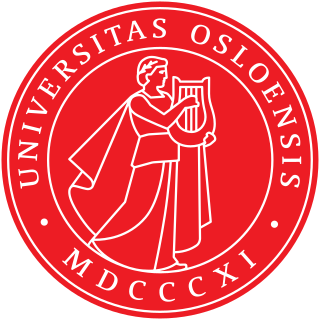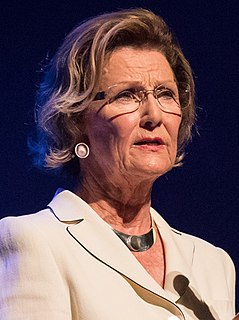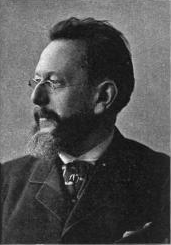
Fridtjof Wedel-Jarlsberg Nansen was a Norwegian polymath and Nobel Peace Prize laureate. He gained prominence at various points in his life as an explorer, scientist, diplomat and humanitarian. He led the team that made the first crossing of the Greenland interior in 1888, traversing the island on cross-country skis. He won international fame after reaching a record northern latitude of 86°14′ during his Fram expedition of 1893–1896. Although he retired from exploration after his return to Norway, his techniques of polar travel and his innovations in equipment and clothing influenced a generation of subsequent Arctic and Antarctic expeditions.

The University of Oslo, until 1939 named the Royal Frederick University, is the oldest university in Norway, located in the Norwegian capital of Oslo. Until 1 January 2016 it was the largest Norwegian institution of higher education in terms of size, now surpassed only by the Norwegian University of Science and Technology. The Academic Ranking of World Universities has ranked it the 58th best university in the world and the third best in the Nordic countries. In 2015, the Times Higher Education World University Rankings ranked it the 135th best university in the world and the seventh best in the Nordics. While in its 2016, Top 200 Rankings of European universities, the Times Higher Education listed the University of Oslo at 63rd, making it the highest ranked Norwegian university.

The Nobel Prize in Physics is a yearly award given by the Royal Swedish Academy of Sciences for those who have made the most outstanding contributions for mankind in the field of physics. It is one of the five Nobel Prizes established by the will of Alfred Nobel in 1895 and awarded since 1901; the others being the Nobel Prize in Chemistry, Nobel Prize in Literature, Nobel Peace Prize, and Nobel Prize in Physiology or Medicine.

Sonja is the Queen consort of Norway since 17 January 1991 as the wife of King Harald V.

The Fridtjof Nansen-class frigates are a class of frigates that are the main surface combatant units of the Royal Norwegian Navy. The ships are named after famous Norwegian explorers, with the lead ship of the class bearing the name of Fridtjof Nansen, the Norwegian scientist, explorer and humanitarian. Five ships were ordered from Spanish shipbuilder Bazan. The total projected cost for all five ships is 21 billion kr. As of November 2018, four are in active service and one has sunk and been decommissioned.
Ivar Asbjørn Følling was a Norwegian physician and biochemist. He first described the disease commonly known as Følling's disease or phenylketonuria (PKU).

The UNHCR Nansen Refugee Award is awarded annually by the United Nations High Commissioner for Refugees (UNHCR) to an individual, group, or organization in recognition of outstanding service to the cause of refugees, displaced or stateless people. It was established in 1954.

The Fridtjof Nansen Institute (FNI) is an independent research foundation specializing in research on international environmental, energy and resource management issues, including political and legal aspects.
The Maudheim medal (Maudheimmedaljen) was instituted by King Haakon VII of Norway on 14 November 1951 in honor of the members of the Norwegian-British-Swedish Antarctic Expedition of 1949–1952, awarded to the participants of the expedition. This expedition was the first to Antarctica involving an international team of scientists. During the expedition, a base known as Maudheim was established on the Quar Ice Shelf along the coast of Queen Maud Land in February 1950. The medal itself is the same as the King's Medal of Merit in Silver with the addition of a silver buckle on the ribbon with the inscription "MAUDHEIM 1949-1952". Only 18 people were awarded with the Maudheim Medal.

The Norwegian Refugee Council is a humanitarian, non-governmental organisation that protects the rights of people affected by displacement. This includes refugees and internally displaced persons who are forced to flee their homes as a result of conflict, human rights violations and acute violence, as well as climate change and natural disasters.

Henrik Mohn was a Norwegian astronomer and meteorologist. Although he enrolled in theology studies after finishing school, he is credited with founding meteorological research in Norway, being a professor at the Royal Frederick University and director of the Norwegian Meteorological Institute from 1866 to 1913.

The Nansen Academy – Norwegian Humanistic Academy is a folk high school in Lillehammer, Norway.

Idun Reiten is a Norwegian professor of mathematics. She is considered to be one of Norway's greatest mathematicians today.
Tim Greve was a Norwegian historian, biographer, civil servant, diplomat and newspaper editor.

The Nobel Prize in Chemistry is awarded annually by the Royal Swedish Academy of Sciences to scientists in the various fields of chemistry. It is one of the five Nobel Prizes established by the will of Alfred Nobel in 1895, awarded for outstanding contributions in chemistry, physics, literature, peace, and physiology or medicine. This award is administered by the Nobel Foundation, and awarded by the Royal Swedish Academy of Sciences on proposal of the Nobel Committee for Chemistry which consists of five members elected by the Academy. The award is presented in Stockholm at an annual ceremony on 10 December, the anniversary of Nobel's death.
Michael Schulte is a professor and chair of Nordic linguistics at the University of Agder in Norway.
Anne-Lise Børresen-Dale is a Norwegian biochemist. She is a senior scientist at Oslo University Hospital and Professor of molecular tumor biology at the University of Oslo. She received the 2002 Nordic Medical Prize. In 2015 she received the Fritjof Nansen medal and award for Outstanding Research from the Norwegian Academy of Science and Letters, and in 2017 she was appointed to Commander of the Royal Norwegian St. Olavs Order by the King of Norway.
The Fram Committee Nansen Award is a Norwegian academic award for polar research named after Fridtjof Nansen. The award has been given out since 1961 by the University of Oslo. It can be awarded to Norwegian researchers who, through a dissertation or otherwise, have made significant contributions to the exploration of the polar areas in biology, geography, geophysics, geology, or oceanography. The award is conferred on Nansen's birthday, October 10.
The Fridtjof Nansen Prize for Outstanding Research is a Norwegian research award. It is conferred by the Nansen Trust and its associated trusts, and it was established in 1896 after the return of the Fram Expedition.

Rebecca Adler-Nissen is a Danish political scientist. She specializes in international politics, particularly in European integration and the European Union, as well as the relationship between the EU and its member states. She is a professor in the department of political science at the University of Copenhagen.












